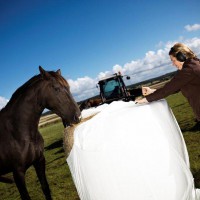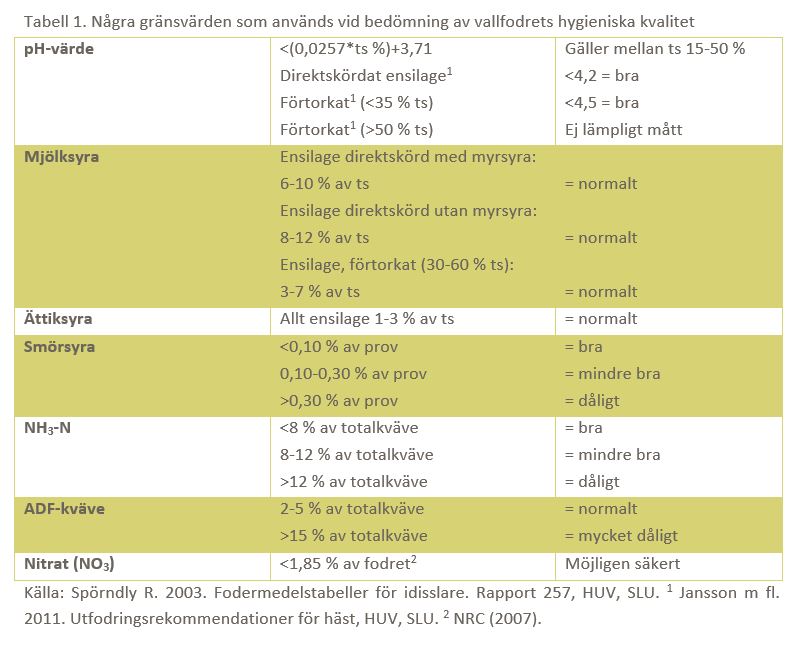The hygienic quality of forage

Forage of good hygienic quality is important for the horse to stay healthy. Hay should be dry and dust free and silage requires a successful ensiling process with good tight baling and air tight storage conditions. Here is a presentation of some chemical hygiene analyses which are used to evaluate how well the ensiling succeeded and whether the forage is of acceptable hygienic quality for the animals. Table 1 shows some limit values used in the evaluation of forage hygienic quality.
The pH value is a measurement of acidity and shows if acid has been produced. Different acids are more or less strong and the pH is the sum of all acids’ strength. In wetter forage the goal is to have enough acid to inhibit all microbial growth. In wilted forage bacteria is also inhibited by the lower supply of water and the pH does not have to decrease as much as in wetter forage. Therefore an acceptable pH varies depending on the DM concentration of the forage and in very dry forages the pH value is no longer a valid measure of quality.
Lactic acid is the acid produced during a successful ensiling process. Lactic acid is produced by lactic acid producing bacteria (LAB), during degradation of carbohydrates. Lactic acid is the strongest acid formed during the ensiling process and therefore also the acid most contributing to the decrease in pH. LAB are the most tolerant bacteria and can continue to grow the longest when the pH decreases. So when LAB stops growing the pH has decreased low enough to inhibit all microbial activity and the silage is now stable for storage as long as it is air tight.
Some LAB can also produce acetic acid, but acetic acid is not as strong as lactic acid and therefore does not lower the pH as much. Also unwanted bacteria, like enterobacteria, produce acetic acid. Too high concentrations of acetic acid are therefore an indication that the ensiling process has not been successful and unwanted bacteria has grown in the forage, especially if at the same time the forage lactic acid content is low.
The amount of ammonia-N (NH3-N) reflects how much of the crop’s protein that has been degraded by unwanted microbial activity. The unwanted protein degradation in silage is mainly done by proteolytic clostridia but also enterobacteria can degrade protein. A high concentration of NH3-N is therefore an indication of unwanted microorganisms in the forage. To visualise how big part of the crop’s protein has been degraded it is common to calculate NH3-N in % of total N (NH3-N/total N).
Butyric acid is not wanted in silage, it is formed mainly by butyric acid producing bacteria, clostridia. High concentrations of butyric acid in combination with high ammonia nitrogen (N)/total N shows that the silage has been damaged by clostridia, which enters the crop when it is contaminated by soil and manure. A good hygiene to prevent contamination of the crop and wilting to at least 30% is a good way to avoid clostridia.
If there has been heating in the silage there has probably been a chemical process going on where protein binds to fibre. Heating in silage/haylage can happen when air enters the bale and unwanted aerobic microorganisms grows, and then the formation of toxins can also be suspected. But heating can also develop early through cell breathing without growth of microorganisms. This can consume a lot of sugar and result in a bad ensiling process due to shortage of sugar. The heating causes a decreased nutritional value when valuable protein binds to fibre which means that either the protein or the fibre is no longer digestible. Analysing ADF-N gives an answer to how much of the forage’s protein content has been bound to fibre, if the ADF-N is 20% it implies that 20% of the protein can no longer be utilised.
Nitrate is a toxic N compound that exists in mainly fresh matter. During certain circumstances the nitrate concentration can be extra high in fresh matter: for example with highly N fertilised leys harvested early, especially in combination with drought after the fertilisation or harvest close after the fertilisation. During the ensiling process nitrate is degraded completely to ammonium or partly to sub compounds like nitrite and other N oxides. Nitrate is less degraded in fresh matter with high sugar contents, that has been wilted or when acid has been added.
You can read more about the forage’s microbiological quality here and about the microbiological hygiene analysis of forage here.
Sara Muhonen, AgrD
References:
Jansson A, Lindberg JE, Rundgren M, Müller C, Connysson M, Kjellberg L & Lundberg M. 2011. Utfodringsrekommendationer för häst. Inst. för Husdjurens Utfodring och Vård, SLU. (in Swedish)
Landin J, Emanuelson M, Pauly T & Spörndly R. 2004. Hygienisk kvalitet i ensilage – kort faktasamling och en åtgärdsguide. Svenska Husdjur, Svensk Mjölk, SLU. (in Swedish)

